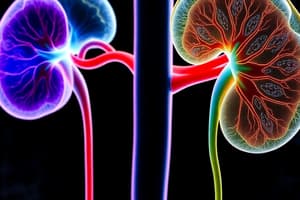Podcast
Questions and Answers
Describe the path of blood flow through the nephron from the afferent arteriole to the efferent arteriole.
Describe the path of blood flow through the nephron from the afferent arteriole to the efferent arteriole.
The afferent arteriole carries blood into the glomerular capillaries in the Bowman capsule. The capillaries then unite to form the efferent arteriole, which exits the Bowman capsule.
What is the function of the peritubular capillaries?
What is the function of the peritubular capillaries?
The peritubular capillaries surround the tubular portions of the cortical nephrons and receive blood from the efferent arterioles.
How do the vasa recta differ from peritubular capillaries in their structure and location?
How do the vasa recta differ from peritubular capillaries in their structure and location?
The vasa recta are straight blood vessels that arise directly from the efferent arterioles of juxtamedullary nephrons and run parallel to the renal tubules into the medulla, while peritubular capillaries surround the cortical nephron tubules.
Describe the path of blood flow from the peritubular capillaries through the venous system back to the heart.
Describe the path of blood flow from the peritubular capillaries through the venous system back to the heart.
What is the key function of the glomerular filtration process?
What is the key function of the glomerular filtration process?
Calculate the total daily urine output if the normal range is 1 L/day to 1.5 L/day and the glomerular filtration rate is 180 L/day with 99% reabsorption: $180\times(1-0.99)$
Calculate the total daily urine output if the normal range is 1 L/day to 1.5 L/day and the glomerular filtration rate is 180 L/day with 99% reabsorption: $180\times(1-0.99)$
Explain how the structure of the Bowman capsule facilitates glomerular filtration.
Explain how the structure of the Bowman capsule facilitates glomerular filtration.
How does the blood supply to juxtamedullary nephrons differ from that of cortical nephrons?
How does the blood supply to juxtamedullary nephrons differ from that of cortical nephrons?
What structural features allow the efferent arteriole to maintain high blood pressure to drive filtration?
What structural features allow the efferent arteriole to maintain high blood pressure to drive filtration?
How does the location of the renal vein relate to the path of blood flow out of the kidney?
How does the location of the renal vein relate to the path of blood flow out of the kidney?
Flashcards are hidden until you start studying




